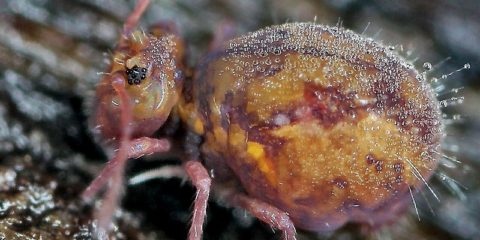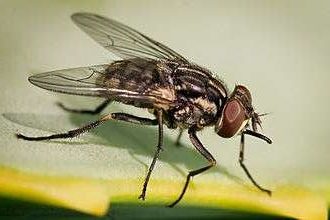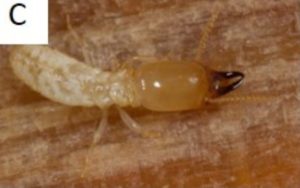By Philippe GARCELON
Presentation
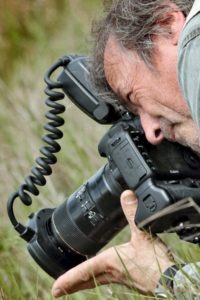
I call myself Philippe Garcelon and now lives in the Toulouse region. I was born in a small village in Cantal and in the 1960’s and 70’s, a lot of my distractions were just nature escapades. I was already starting my first insect collections.
Unfortunately I will leave my “playground” for higher studies at the end of which I joined a large French group. At fifty years old, then a manager, I decided to change my life to devote myself to interests closer to my aspirations.
I first turned to astronomy and astrophysics, which today allows me to carry out regular missions on the coronograph of the Pic du Midi. But I do not forget the insects or the arachnids which are an excellent pretext to devote me to the macrophotography that I discover.
It’s fortuitous that in 2016, I met my first collemboles when I didn’t know they existed. I seek to document them and quickly notice the relative poverty of affordable publications concerning them. So quickly, these small arthropods fascinate me, to the point that I feel the need to share this craze.
Of course, I cannot claim the competence of the entomologist by profession to propose anything other than a popularizing approach to their subject. For all that, I found a certain legitimacy of my purpose through a noble engine which animates me, that of passion.
Where live collembola ?
If unknown, they are however scattered a little everywhere on Earth. They live on the ground, on the water around ponds, in high mountains, in deserts, caves and even under polar latitudes. Currently more than 8000 species have been recorded and probably more remain to be discovered. We don’t suspect the abundance of these creatures. In some habitats, their density can reach several hundred million individuals per hectare, all species combined. For example, when we walk in a natural environment, under the imprint of a single step, there are sometimes several hundred of them moving between the surface and a few centimetres deep. In forest habitats where decaying dead leaves abound, it is not necessarily exceptional (in some areas where oak dominates) to find 200,000 to 300,000 collembola per m² !
What are the first written traces about collembola ?
Collembola are absent in ancient literature. It seems that Aristotle (-384 to -322 B.C.) was the first to mention”vers” which could well be collembola. I quote:” Snow itself produces worms as it ages. As time makes it red, these worms are red too: they are hairy. In Medie they are white and great. The snow worms are all lazy to move “. Then, it is necessary to wait more three centuries before finding an indirect mention with the text of Aristotle, evoked succinctly by Pliny the Elder (23-79) in his work “Natural History”.
The first plausible mentions of this arthropod, then described as a “worm”, date only from the end of the XVIIème century. For example, in the ephemerides of the “Academy of the Curious of Nature in Germany”, Doctor Charles Raygerus (Hungarian doctor) tells how in 1672″It fell in a meadow in Hungary more than ten species of worms with snow, which lived there, & that one lives there to win by troops during more than four days … “».
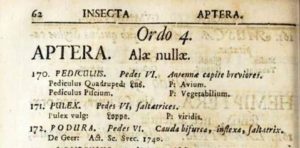
Few years later, a certain Doctor Jean Chrétien Frommannus observed on December 2, 1684″snow fleas “. But it was only at the beginning of the XXème siècle that researchers seriously studied these animals previously classified as insects. The term”Podura” appears in Carl von Linné’s first classifications (circa 1740) within the”Aptera” (meaning without wings) and is described as follows: “curved and dancers with a forked tail”.
Or are they in the classification ?
Long time considered as insects, collembola form today a class in its own right within the hexapod subbranch as shown in this table.

In the four orders, the currently identified species are distributed as follows

*Data updated to 5-11-2017, because we discover very regularly new species, in particular with DNA barcode studies, allowing to dissociate species on morphologically very close subjects
How can we observe them ?
Usually, you have to get on all fours, in the undergrowth, on a carpet of dead leaves and scan the ground. Tiny (0.25 to 4.5 mm), they cohabit with other smaller animals such as mites. If you can’t see anything on the first approach, then gently lift the top layers of the litter and start observing again. Many of them jump when they feel in danger, which hinders observation but, in return, makes it easier to find them.
How to photograph them ?
Photographing such small animals, especially when one wishes to do it in a natural environment, requires the use of a minimum of material and especially a good knowledge of their biotope. In order not to be discarded, it is advisable to look for the largest (Orchesella – approx. 4.5 mm) photographable with a classic macro lens. But, very quickly, we are confronted with the dimensional pitfall and the technical limits of our equipment. Indeed, Orchesella, which is already a very small subject, is still ten times larger than a good part of the other collembola that measure in the order of a millimeter or even less (0.25 mm for the smallest). The acquisition of extension rings or a focal multiplier becomes essential. But the best solution is to use the unique CANON 65MM MP-E F/2.8 MACRO lens, which allows a x5 magnification ratio. The inevitable counterpart is that at magnifications (x3 or x5) with, for example, an aperture f/8, the depths of field are reduced to 0.25 mm and 1.03 mm respectively. In other words, mastering such an objective is not an easy task. But this is the price to pay to approach this other universe, that of microphotography.
How to locate collembola on the geological time scale ?
They were among the first arthropods to colonize the planet 400 million years ago. The Earth was a body of water from which emerged a few blocks grouped around a continental mass called Gondwana. It was during the Silurian and Devonian periods that chlorophyll plants and several large animal groups (mainly Arthropods and Vertebrates) acquired anatomical structures and physiological functions that enabled them to live out of the water and conquer the land surface. The vast swampy areas and shallow areas are thus populated by new amphibian species. On Earth, among the well established bacteria also emerge arthropods, such as isopod crustaceans (sowbugs), myriapods (thousand legs), chelerates (ancestors of spiders and scorpions), some insects and especially the first collembola. The first known fossils (below) classified as collembola (Rhyniella praeccursor) were discovered in 1926 in Rhynie near Aberdeen, Scotland, in deposits of old Middle Devonian red sandstone (ca. -380 Ma), by Hirst & Maulik who related them to the present Poduromorphs.

Since that time, they have survived massive extinctions like the Cretaceous (-66 Ma) which saw the great dinosaurs disappear. One finds some in fossil ambers of the Baltic, dating from -40 Ma and the most surprising is that these last ones almost resemble features to current species. Observing them is therefore a kind of time travel.
Morphology
Different appearances, their physiological functions are similar and they have common characters: They are entognaths (mouthparts retracted in the head) which differentiates them from insects, have segmented antennas, 3 pairs of legs attached to the 3 thoracic segments and 6 abdominal segments. Their bodies may be covered with hair or scales. Their skin has hydrophobic properties, like our water-repellent fabrics. They may have patterns or various pigmentations.
There are four orders of collembola
- Entomobryomorphs living on the surface, with a jumping organ called furca and whose elongated body has harder teguments covered with hair
- Poduromorphes, which rather live underground, do not jump, are sometimes blind and have a soft and often pudgy body
- Symphypleones, fused chest and abdominal segment jumpers giving them a globular appearance
- Neelipleones (order collecting very small “globose” collembola)
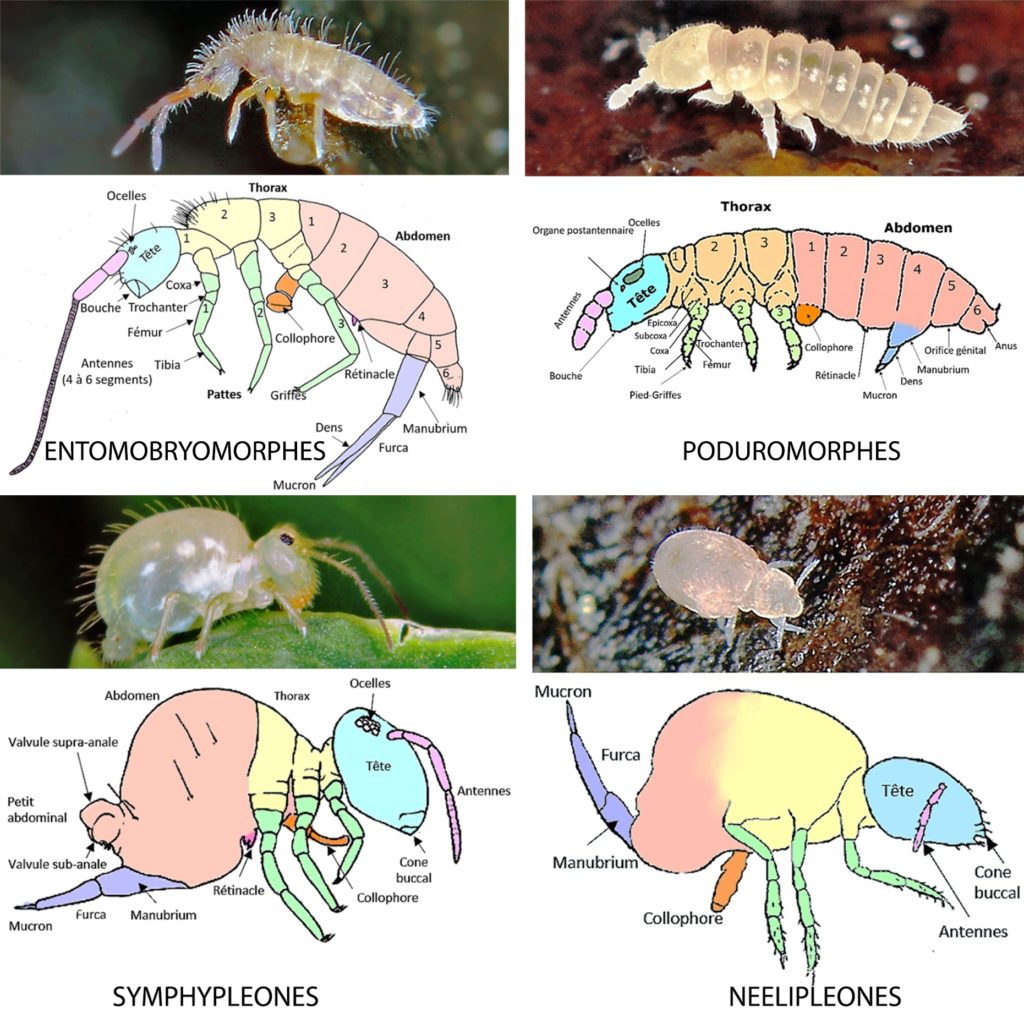
Life style
Their physiology requires a high level of humidity, they live and reproduce better the higher the humidity. It is therefore easier to see them evolve in late autumn in winter or spring than during dry periods when they take deep refuge and limit their movements. Their natural lifespan is approximately one year. Their diet consists of decomposing plants and may also include micro-organisms or fungi. Their reproduction can be sexual or asexual (parthenogenesis).
Reproduction
A share of them engage in some kind of love parades (see video here : love parades ) which recall choreographies coded according to species and which always have as object the efficiency of reproduction. Depending on weather conditions, eggs take one to four weeks to hatch. They do not have a larval state, the small collembola are already born with the same morphology as their parents. Their size will change regularly through successive molts.
Some anatomical specificities
La Furca organ jumper
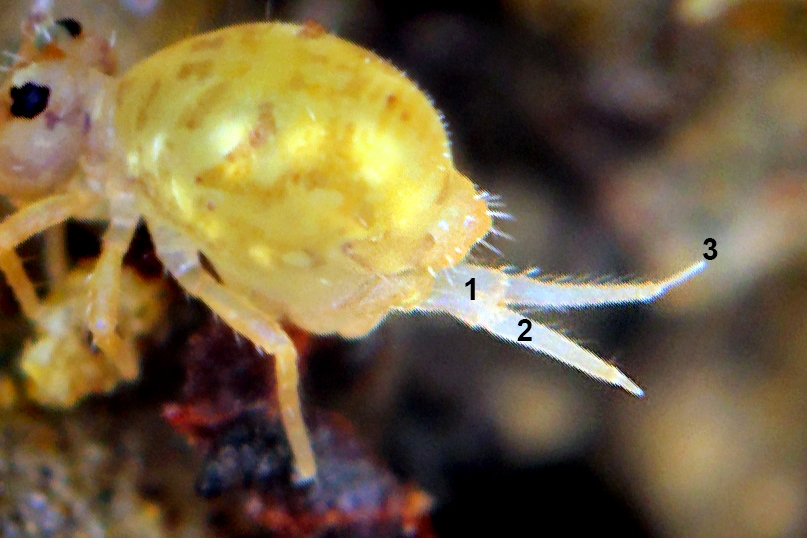
Unlike insects, they have no wings. On the other hand, their anatomy includes their own organs, such as the”furca” which they use to make jumps to escape predators or to quickly leave the environment where they evolve when they feel a danger. Although in some cases it can control the direction in which it jumps, the Collembola generally does not control all the components of its jumps and, therefore, cannot use them as an ordinary means of locomotion. On the image above, the furca, attached to the fourth abdominal segment is composed, at its base, of manubrium (1) which contains the muscular part and which is divided into two branches each consisting of dentes (2) each terminated by an article named mucron (3).
The collophore
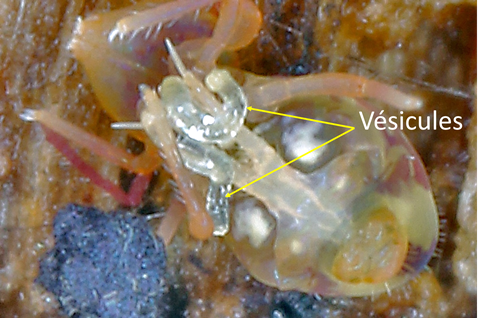
The collembola also has a ventral tube called collophore, a kind of tube that is more or less elongated depending on the group and consists of a tube with a pair of thin-walled excretory vesicles at its base. These retract into the cylinder via twelve so-called retractor muscles. They are equipped with sensory organs interpreted as hydroreceptors, osmoreceptors and pH receptors (acidity/basicity) so the animal can increase or decrease these values by leaving or retracting its vesicles. The main function of the collophore is therefore water, through the transport of water and ions to the hemolymph. This organ would finally be used for secondary functions, as for example, thanks to an adhesive gland, to maintain the collembole in place when it evolves on smooth surfaces. We can also mention the respiratory function thanks to the passage of oxygen through its thin wall.
The cuticle
The cuticle (skin) also has amazing characteristics. The study of the Collembola’s physiological functions teaches us that it breathes through its cuticle and that a drying of the cuticle would be fatal to it, which is why it likes wetlands. But the excess moisture would be just as fatal if he were to cover his cuticle. It is therefore essentially to protect itself from the risk of asphyxiation that the collembola has developed a cuticle whose nanostructure has a complex organization that allows it to effectively repel water. In order to allow a good cutaneous breathing, the cuticle must indeed remain clean, dry and free of any contamination which could reduce its functional surface.

Example : The hydrophobic properties of the cuticle of the collarbone are highlighted on this photograph of a Dicyrtomina ornata (Here we must take into account the evaporation of water contained in the substrate and the increase in humidity of the air that follows. In contact with a cold surface this moisture condenses in the form of fine droplets, as can be seen in nature on various supports: grasses, mosses, cobwebs etc…).
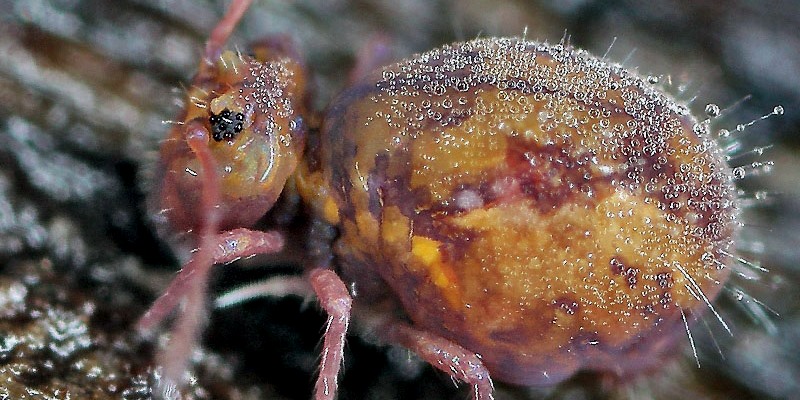
Explanation : In this case, the thing is not so simple because it is not because of condensation alone that droplet formation is observed. Indeed, the structure of the epicuticle of the collembola forms a grid of open cells (review the diagram above) in which the humidified air is trapped. The absence of air flow within this structure will have the consequence of increasing the humidity rate which, becoming higher than that of the ambient air, allows the formation of condensation; not because of a difference in temperature but because of the differential humidity rate, because at constant temperature, the dew point (formation of droplets) depends on the differential saturation of the air with water (to understand this phenomenon, see dewpoint).
One will thus be able to observe, under certain conditions, the formation of these fine droplets due to condensation on the one hand and, on the other hand, to the hydrophobic properties of the cuticle (mentioned previously). The cuticular pillars, by their structure and also thanks to their lipid-rich surface, reject these droplets on the surface. The finest of them then agglomerate to form larger and larger liquid spheres, until gravity drags them to the ground.
Is there species with specificities ?
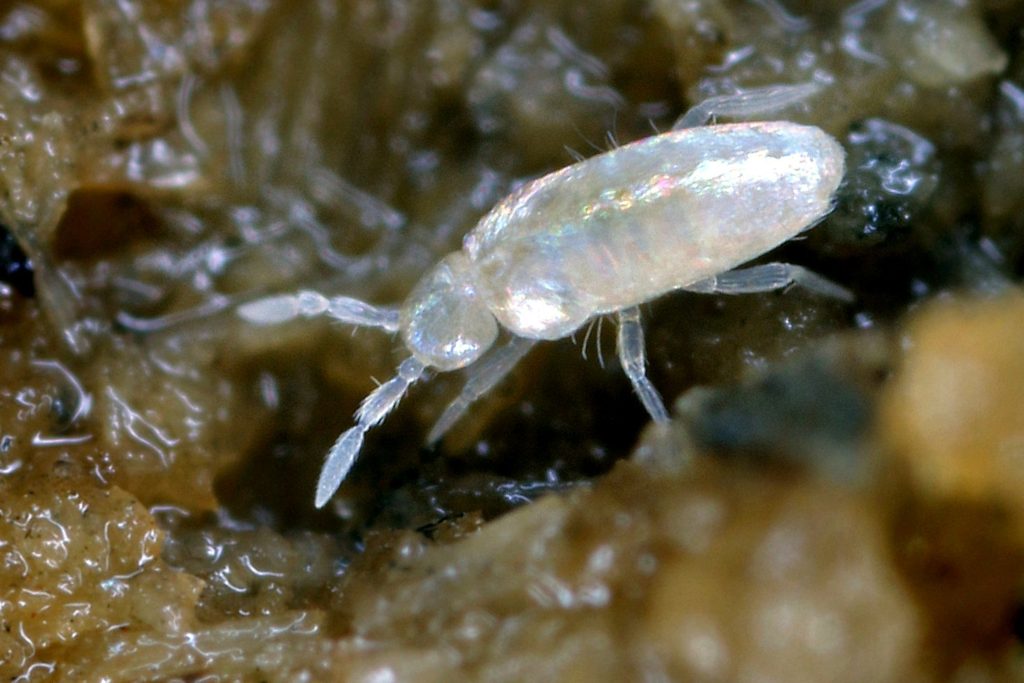
If I refer to my own observations, I could only mention the Cyphoderus albinus which has the particularity of living in perfect complementarity with certain ants. Indeed, in exchange for cleaning work (these collembola eat the mushrooms likely to contaminate the underground maternity ants), the ants mark this collembola with the pheromones of their community, so that the latter consider them as their own.
Some Poduromorphs of the order Neanurinae, such as Neanura muscorum (image below) although easy to predict in appearance, due to their morphology and weak defensive capacities seem totally neglected by mites, spiders or myriapods which are their usual predators.
Researchers who have conducted chemo-taxonomic studies have discovered that these species secrete repellent substances (here Dimethoxybenzene) that are more than enough to deter predators. This research carried out on numerous other species has made it possible to highlight changes in defensive strategies directly linked to the predatory intensities that weigh on them.
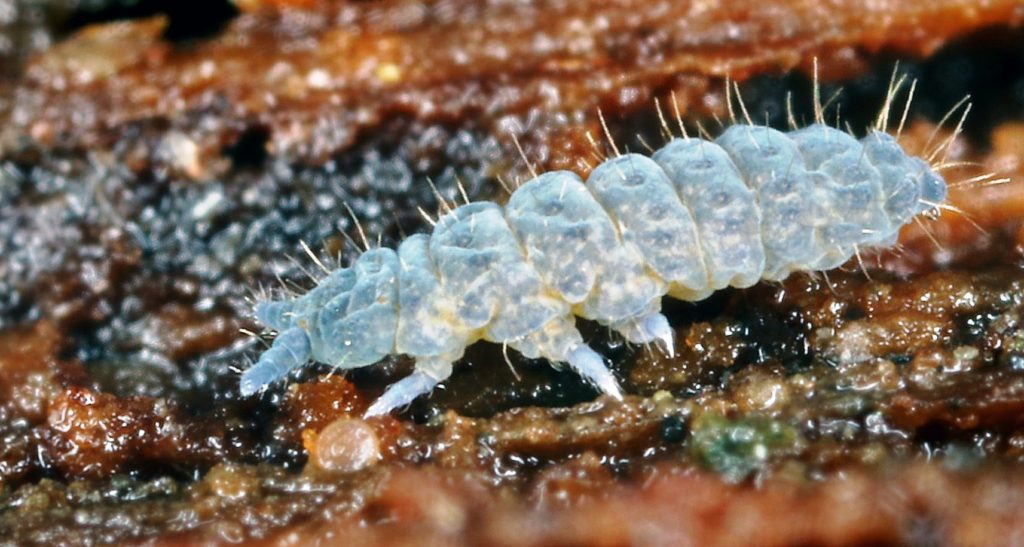
What role do collembola play ?
I) Soil decomposers
They play an essential role in the decomposition of organic matter, contributing to the ecological balance of microfauna by allowing the spread and regulation of fungal and bacterial populations. Indispensable for the circulation of vital plant nutrients, they play a role upstream in the cutting and fragmentation of plants before micro-organisms (bacteria, fungi, protozoa, algae, nematodes…) intervene.

On note différentes phases dans le cycle fragmentation organique à travers l’illustration ci-dessus. At each stage the collemboles play a major role. A chronology can be established:
- First, the fallen leaves of the tree pile up on the ground where they are first washed by the rains. The microfauna comes into action. Arthropods (collembola, mites) begin to attack the epidermis of leaves where the first holes will soon appear
- Small dipteran larvae enlarge indentations and microflora (bacteria and fungi) enter into action
- Arthropods continue to cut leaves, the strongest of them attack their softened veins by microflora
- The fragmentation of the debris continues and some of it mixes with the droppings from the previous steps
- Dissemination of organic residues and ambient autumn humidity stimulate microflora and accelerate the dispersion of mineral elements
One can deplore that at the end of this cycle, the chemical compounds not assimilable by these living organisms, if they do not kill them, dangerously mortgage the cycles of biodegradation to come. As time goes by, increasing concentrations of harmful substances are formed in the soil. Any action aimed at preserving biodiversity is not justified solely by ideological considerations, but more simply by a manifestation of the instinct to survive. Thus, the man who spreads insecticides or other poisons targeting parasitic animals and plants (substances modestly named phytosanitary) benefits only a very short term. On the other hand, he can be assured that his actions will have consequences of which he will one day be a victim.
II) Ecological marker
In soil quality studies, collembola are valuable aids. The “star” of laboratories, Folsomia candida has become an ISO standard species. Used in many experiments, the latter led to the establishment of the ISO11267 standard which determines the quality of a soil according to the inhibition to reproduction of this species. The behaviour of collembola during the resistance tests to which they are subjected, allows researchers to establish statistics on the nuisances caused to soils by chemical aggressions due to human activities (pollution with metals, pesticides or agricultural and domestic waste).
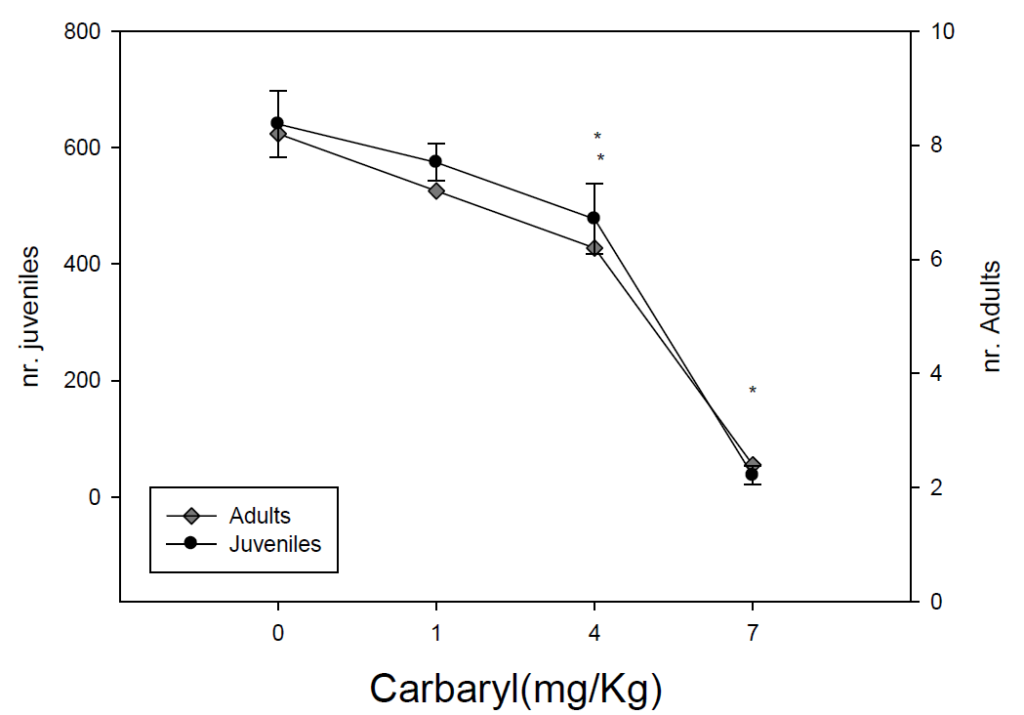
The example opposite shows the behavior of Folsomia candida in contact with”carbaryl “, an insecticide and growth regulator used in agriculture to control fruit drop.
Here, two population types are tested: juveniles and adults, over a carbaryl concentration range of zero to 7 mg/kg substrate over a 28-day period. As the graph shows, the results are edifying. With a dose of 6 mg, the populations are reduced by half, whereas with 7 mg, they are totally decimated. It can be noted that during this exposure the collembola continued to reproduce; between 4 and 7 mg concentration significant differences were recorded with a test population (not exposed). However, 7 mg/kg represents a threshold above which everything dies. EC50 (effective concentration) is 5.1 mg/kg and LC50 (lethal concentration) is 5.4mg. We therefore understand where the recommendations for use given by the manufacturers of such products come from…
This example highlights the harmful effects of all these chemical molecules that agriculture uses. We can assume that the impacts on man will, in the long run, have serious repercussions on his health. The doses of these substances that enter our bodies may be infinitesimal relative to our body mass, but just as they accumulate in our soils, our body stores them until one day, concentrations reach fatal thresholds, like those that kill thousands of small Folsomia candida every day in research laboratories around the world… And what do we do during that time?
A conclusion ?
It seems to me that we should learn to remain humble before these “insignificant creatures”. Collembola show us a path from which we too often deviate by our practices; that of the preservation of natural resources, without which the massive extinction that already began in the 20th century could quickly expose our species to the forefront, in front of our inability to think and act beyond the duration of a generation.
A big thank you to “Passion Entomologie” for giving me the opportunity to talk about collembola. If you wish to know more about them I propose you to consult the site that I dedicate to them https://collemboles.fr
Recommendations for books on this theme
- Planet Collemboles : The secret life of soils
(Philippe Lebeaux & Jérôme Cortet – Biotope Editions – 252 pages – November 17, 2015)
- These tiny animals that surround us
(Régis Cleva, Yves Coineau & Gaëtan du Chatenet – Delachaux & Niestlé Editions – 77 pages – October 3, 1997)
- Le petit collembole illustré (Jean-Marc Thibaud & Cyrille A. D’Haese – 60 pages – 2010 – Download here)
- Biology of the spingtails (Stephen P. Hopkin – Oxford University Press – 344 pages – May 15, 1997)
Photo galleries
- Collembola/springtails from around the world : The largest existing gallery that compiles collembola photographs across the World
- https://www.animailes.com/portfolio/la-microfaune-et-mesofaune-du-sol/ : Gallery of Philippe Lebeaux, collembola photographer
- https://www.flickr.com/photos/jeromepi/albums : Jérôme Picard’s Gallery – Collembola’s are in a good place, classified by specific albums
Philippe Garcelon’s photographic galleries
Sites dedicated to collembola
- http://www.collembola.org/ : Reference site maintained by Frans Janssens, member of the Royal Society of Entomology of Antwerp. Laboratory associate in the Department of Biology, group of evolutionary ecology at the University of Antwerp in Belgium
Other useful links
- https://www.insecte.org/spip.php?rubrique25 : Site with a gallery of collembola images
- http://aramel.free.fr/INSECTES6-1.shtml : Site maintained by entomologist Alain Ramel with a section dedicated to collembola
- http://www.bioone.org/doi/10.5252/z2017n3a1 : Site where you can download the PDF from the “catalogue des collemboles de France” established by J.M. Thibaud.

